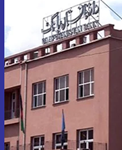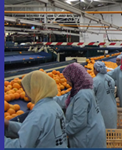 |
National Air Corridor Plan Between Afghanistan and IndiA
India is the second largest destination for Afghan exports. However, trade levels are inhibited by Pakistan, which frequently closes its borders with Afghanistan and does not allow Afghan traders to transit through their country to trade with India. One potential strategy for circumventing this constraint is by increasing trade levels through air routes
Publish date: Oct 2016
Browse the Research Document
|
 |
Quarterly International Economic Report(Trade)
This report is about Afghanistan international economic report, in particular the international trade. This will be prepared on quarterly basis. We will analyze the Afghanistan exports and imports with its trading partners. The purpose of this report is to compare quarterly changes in Afghanistan international trade. At the end we will also provide recommendation on trading and an overview of key sectorial improvement. Let us first have an understanding of Afghanistan trading.
Publish date: Nov 2016
Browse the Research Document
|
 |
Afghanistan: Quarterly Economic Report
This report is the first product from our economic team. It will be provided to you on a quarterly basis, and will cover overall economic growth, inflation trends, balance of payments issues, and provide an overview of key economic sectors.
Publish date: Nov 2016
Browse the Research Document
|
 |
Construction Sector Overview
This report on housing construction sector of Afghanistan has four main objectives. This includes (1) providing an overview of housing construction industry of Afghanistan, (2) providing an overview of the major players, (3) examining the possibility of providing low cost housing for militaries personnel and other civil servants, and (4) examining ways to help government to stimulate the private housing market.
Publish date: Apri 2017
Browse the Research Document
|
 |
Afghanistan's Oil & Gas Industry
The goal of this report is to provide options to improve Afghanistan’s oil security -both in the short-term and long-term. In the short-term, we: (1)to asses FLGE’s capacity to supply oil and gas to the MoD& MoI, and (2) to evaluate the option of building a strategic petroleum reserve (SPR) in Afghanistan. We find that FLGE likely does have the capacity to supply Afghanistan’s domestic needs, and that operations can be further improved withsome organizational restructuring and financial investments. We also find that the creation of a limited 350,000 MTs SPR –with the reserves comingled with private stocks –seems to be the best SPR option over a medium-term horizon. In the long-term, we provide recommendations to increase upstream oil production and build the country’s refining capacity. Currently private sector refineries have the capacity to refine half of total oil supply of Afghanistan, with combined capacity of 32,500 barrels per day.
Publish date: April 2017
Browse the Research Document
|
 |
Pharmaceutcal Sector of Afghanistan
Afghanistan used to produce herbal and chemical medicines for export decades ago. During the Dr. Najeeb regime, Hoechst pharma used to be the main producer of pharmaceu;cal products in Afghanistan, but has since stopped opera;ons. Unfortunately, the war era affected the produc;on and today more than 90% of medicines are imported from other countries.
Publish date: April 2017
Browse the Research Document
|
 |
Mobile Banking in Afghanistan
In this presentation, we will provide all information regarding current scenario of mobile banking in Afghanistan, we will also cover regional countries. The report will further analyze and summarize the current performance of telecom operators in terms of investment, revenue, customers, and coverage. Currently three mobile operators; Roshan, Etisalat, and AWCC are providing mobile money services across the country. The mobile money services are available in 27 provinces with 357k customers which makes 1.3% of the entire population.
Publish date: May 2017
Browse the Research Document
|
 |
Afghanistan’s State Banks Overview
This is the monthly presentation on the financial status of the three state owned banks. In this presentation, we will provide financial highlights of the state owned banks in terms of equity, loans, deposits and profitability. These three banks, Bank-e-Millie, Pashtany and New Kabul bank have performed well during this month. The total equity capital of these banks have increased by 3% from AFN11.2B to AFN11.5B from February to March 2017.
Publish date: May 2017
Browse the Research Document
|
 |
Sukuk in Afghanistan
This presentation will summarize the Sukuk market both domestic & globally and its major components. The GoIRA has planning to launch Sukuk (Islamic Bonds) to (a) finance public expenditure, (b) bring idle cash into circulation, and (c) promote economic growth. In particular this memo will cover the following Sukuk issues: (1) a comprehensive study of Sukuk Market (2) establishment of Sukuk law in Afghanistan, (3) The major Sukuk types, and (4) Case studies of Sukuk management in Malaysia, Saudi Arabia, UAE, Jordan and UK Countries. At the end provide a set of recommendations to move forward with finalizing the legal and regulatory frameworks of Sukuk industry in Afghanistan.
Publish date: May 2017
Browse the Research Document
|
 |
Afghanistan’s Insurance Industry Sector Overview
This presentation will provide an overview of the Insurance industry of Afghanistan. The presentation will provide details in terms of the contribution to the GDP, number of players, importance in the economy and provide suggestions for the betterment of the industry. The size of the Insurance industry in the GDP of Afghanistan is very small. Total gross written premiums (GWP) reached AFN101M in 2014*.
Publish date: May 2017
Browse the Research Document
|
 |
Coal Sector Overview
The purpose of the is report is to provide an overview for the feasibility of coal for power generation in Afghanistan. Coal remains the primary source of power and the secondary source of energy in the world. As of 2015, it has provided 41% of world’s electricity and 27% of world’s energy. The reason why coal dominates the power and energy ground is due to its great quantity, wide distribution, and affordability.
Publish date: May 2017
Browse the Research Document
|
 |
Afghanistan's Power Sector Overview
The Afghanistan power system contains four different networks that are not fully interconnected. A completely integrated and developed national grid is expected by 2019-20. further to that the country’s power system is comprised of 10 isolated grids or islands supplied through different power system by 220KV and 110KV. The current grid based electricity only covers 30-35 percent of the population. Moreover, lack of grid connectivity and inadequate supply have resulted in electricity inaccessibility in rural areas and power failures in major cities like Kabul. The current Afghanistan’s electricity consumption stands for 130KWH/year/person which is considered very low compared to south Asia average of 667KWH/year/person
Published by the Office of the Senior Economic Advisor in May 2017
Browse the Research Document
|
 |
Afghan Fiber Optic Network Analysis
Afghanistan’s Fiber optical network is owned by government. Currently it is connected with 24 provinces and its active length is 4000/km. 101 million USD has been invested on this fiber optical network. In 2016 Afghan fiber optic revenue increased to USD$70 million from USD$0.4 million in 2008.
The remaining nine provinces will be contacted through the fiber optic in the future by building 1305 km link, to contact these remaining provinces Afghan telecom needs almost USD$33 million. The international routes of Afghan fiber optic currently connect with Pakistan, Iran, Tajikistan, Uzbekistan and Turkmenistan. In the future, it will connect with China, through a 480 KM connection from Faizabad City, Badakshan to the China Border.
Published by the Office of the Senior Economic Advisor in June 2017
Browse the Research Document
|
 |
Afghan Telecom Corporation Analysis
The presentation describes profound information regarding Afghan telecom in terms of services, coverage, and financial situation of the company. It further provides international overview and comparison of Afghanistan with regional countries in terms of Tariff, fixed broadband subscription, and internet penetration. At the end of the presentation, we will have conclusion followed by recommendations.
Published by the Office of the Senior Economic Advisor in June 2017
Browse the Research Document
|
 |
Afghanistan’s State Banks
This is the monthly presentation on the financial status of the three state owned banks. In this presentation, we will provide financial highlights of the state owned banks in terms of equity, loans, deposits and profitability. These three banks, Bank-e-Millie, Pashtany and New Kabul bank have performed well during this month. The total equity capital of these banks have increased by 2% from AFN11.7B to AFN11.9B from April to May 2017.
Published by the Office of the Senior Economic Advisor in July 2017
Browse the Research Document
|
 |
Cold Storage Industry of Afghanistan
This presentation is intended to provide an analysis of the cold storage industry and its impact on the agricultural products of Afghanistan. Particularly, in this report we will cover (1) the regulatory body, (2) market size, (3) major players in the market, (4) its contribution to the GDP, and (5) employment.
The Agriculture sector counts for up to 40% of Afghanistan’ GDP. More than 80% of the population relies on Agriculture for their livelihood. The main crop continues to be wheat. But horticultural crops provide important additional income to farmers. One of the main problems of this sector is shortage of cold storages. During the season, the supply of an agricultural products becomes abundant. Therefore, the price declines sharply, the farmers struggles to recover their expenses. So, cold storage allows them to sell products out of season with 2-5x the price at season. Moreover, 40% of agricultural products are wasted due to lack of cold storage rooms in Afghanistan. Afghan Area under refrigeration is 24,000 square meters compared to 131M square meters in India.
Published by the Office of the Senior Economic Advisor in July 2017
Browse the Research Document
|
 |
Afghanistan Water Management
The presentation will provide a profound information regarding the current basins of Afghanistan, the share in each basin, international case studies, and water treaties. This will further analyze the regional basins in terms of area and irrigation. At the end of presentation, we will provide recommendations.
Afghanistan has total five river basins which includes (1) Amu Darya basin, (2) Helmand, (3) Indus, (4) Northern, and (5) Harirod-murghab. Helmand River is the largest basin in terms of area (it covers 262K km2 area with a population of 3.5M). In terms of irrigation, the Northern Basin is larger (irrigating 623K hectares), followed by the Kabul Basin (which irrigates 488K hectares). From electricity perspective, in 2015-2016 Afghanistan produced 1,034M KW/hr annually, with the highest contribution coming from hydro power 889.5M KW/hr (86.1% of the total production). In terms of import, Afghanistan Imports 3,779M KW/hr and large contribution comes from Uzbekistan (1,354.1M KW/hr).
Published by the Office of the Senior Economic Advisor in September 2017
Browse the Research Document
|
 |
Kabul Municipality Presentation
This presentation is intended to explain the current condition and the existing issues on the Kabul Municipality (KM) procedures. Here, we will specifically outline: (1) legislation, (2) KM financial system Revenue Collection Model, (3) land valuation, and (4) services of KM.
Currently, KM suffering various issues in its legislation, which is almost outdated and is not will responsive for managing urban issues. The municipal law package consist of the followings; (1) different laws, (2) regulations, and (3) decrees. These sections have different articles of matter, which some of the specific articles faces serious problems.
Published by the Office of the Senior Economic Advisor in September 2017
Browse the Research Document
|
 |
Afghanistan Dams and Irrigation projects
This presentation will provide an analysis of the existing and proposed dams in Afghanistan. Our analysis includes: (1) dam analysis, (2) irrigation system analysis, (3) small scale irrigation projects, and (4) farm level profitability. This presentation will then provide precise recommendations based on our analysis. For the analysis of the dams, we calculated the NPV of the given 69 dams. Out of these 69 dams, only 16 generated a positive NPV, and are feasible to invest. The remaining dams generate a negative NPV and are not feasible. We recommend MoEW and MRRD to consider the NPV framework for prioritizing DAMs prior to pre-feasibility and feasibility studies
Published by the Office of the Senior Economic Advisor in January 2018
Browse the Research Document
|
 |
Orphanages in Afghanistan
This report highlights the current status of orphanages in terms of management, operations, capacity, and challenges. At the end of the report, we will provide recommendations on how to improve current conditions of the orphanages.
According to MoLSAMD, there are 250K orphans in all over Afghanistan, however only 11.8K of them are under care of orphanages (4.7% of total orphans). There are a total of 61 orphanages (government-run and privately-run) operating across 23 provinces. In the government-run orphanages, 5K orphans are under care, while the remaining 6.8k orphans are under care by private orphanages. The current budget of orphanage directorate is AFN72 million ($1.05m). A total of AFN6.4K/month ($95) is spent on each orphan.
Published by the Office of the Senior Economic Advisor in May 2017
Browse the Research Document
|